System Preferences in OS X 10.9, Mavericks: Parental Controls (Amended)

AMITIAE - Tuesday 7 November 2013
|
System Preferences in OS X 10.9, Mavericks: Parental Controls (Amended) |
 |
|
|
By Graham K. Rogers
The ability to limit user access in earlier versions of OS X, were beefed up considerably with the arrival of Parental Controls in OS X, 10.4, Tiger. There has been some refining since then. As well as the ability to prevent use of certain applications now, the limits that may be set to URLs include both specifics and types of sites (including online multiplayer games); email access (sending and receiving) can also be controlled. Logs of activities may also be monitored. There is also the ability to limit the number of hours that an account is used, including beginning and end times. This may help families with those addicted to playing games non-stop.
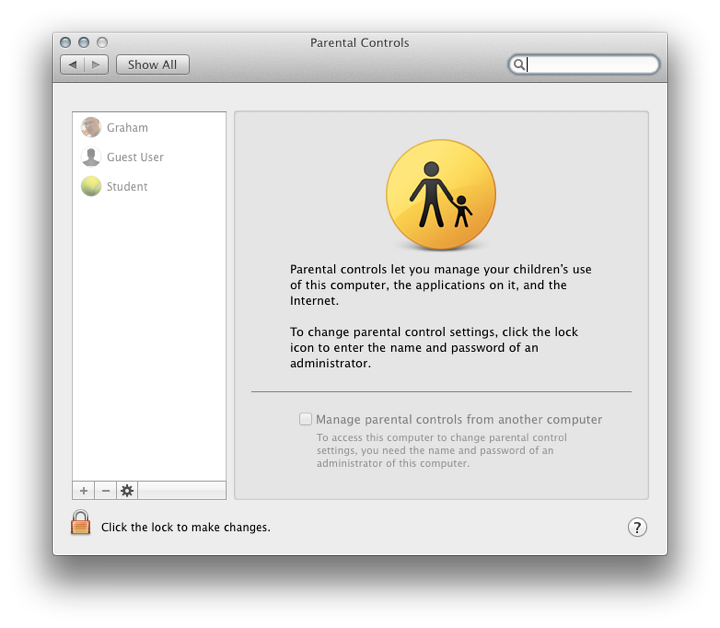
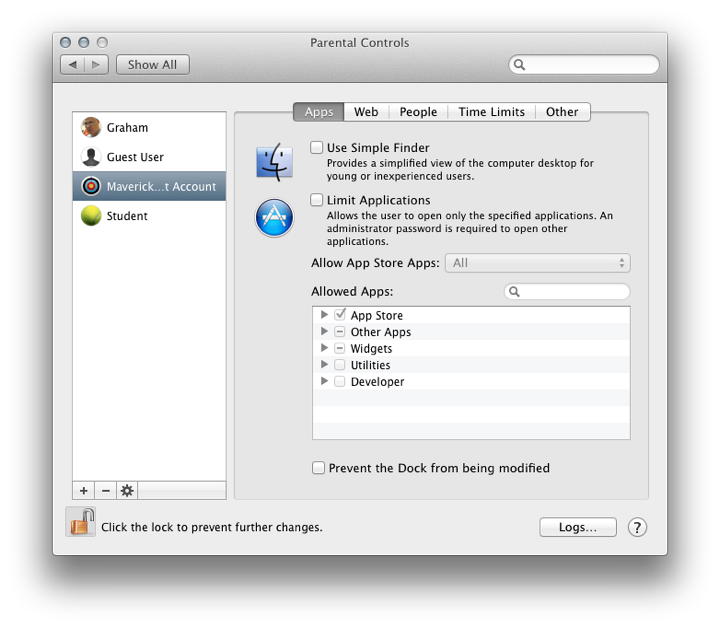
The - (delete) will offer to delete a highlighted account. This is not to turn off Parental Controls. Using the "gear" icon reveals a menu with shortcuts for actions: settings for one account can be copied and pasted to another; parental controls may be turned off for any specific account; and Allow Remote Setup may also be activated here.
AppsWhen a new account is created in this panel, or when applying Parental Controls to an account that has already been created, the first button (Apps) controls the Finder and applications. It is in two sections. It is slightly changed from before, with the removal of the Dock icon and a change in wording.The upper part of the panel displays a checkbox to turn on a simple Finder: in the account a basic panel displays icons for permitted applications. When parents work in that account, they can turn on the full Finder with an Admin password. A second checkbox is marked Limit Application: the user in that controlled account may only open specified applications. When this is on, a button marked Allow App Store apps is live, with selections from "All" to "Don't Allow" with age limits between: Up to 4+, 9+, 12+ and 17+ as before. The panel below this is only live when the Limit Applications box is checked. It controls applications that may be used (with or without the simple Finder). By default, only some are allowed. By checking/unchecking boxes any or all may be selected or deselected. At the bottom of this panel is a checkbox to control Dock use. The wording has been changed. If selected the user is prevented from modifying the Dock. A button (available for Apps, as well as Web, People and Other) reveals activity logs in the account (see below).
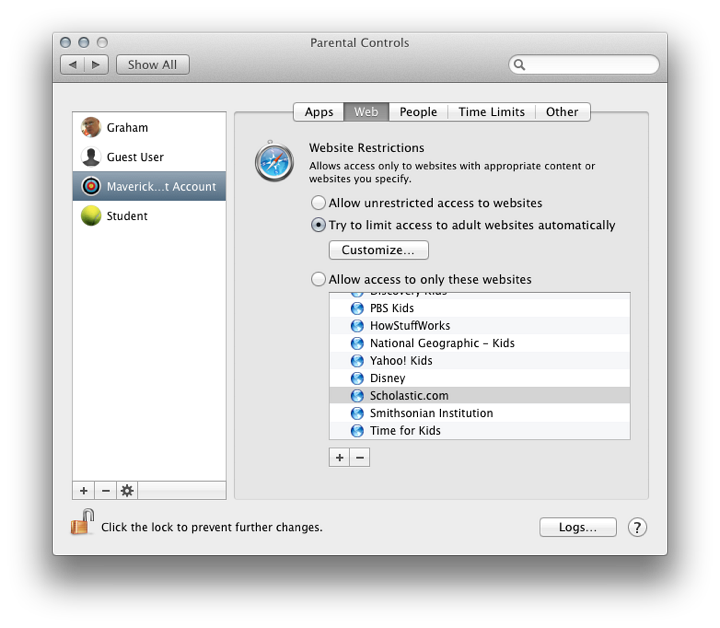
WebThe "Web" section limits a user's access to the World Wide Web. There are three radio buttons: Allowed unrestricted access to websites; Try to limit access to adult websites automatically; and Allow access to only certain websites.The second button for controlling limited access tries to use recognized content filters. A Customize button allows access to certain sites that are erroneously blocked, or blocks those that have been wrongly allowed. The third option allows access only to specific sites (a "whitelist"). The whitelist already contains a number of sites considered safe, such as the Apple start page, National Geographic, Disney and the Smithsonian Institute. At the bottom of the panel are + and - icons so that parents may add suitable bookmarks or folders. Any sites on the list may be removed. More information on using Parental Controls is available on the Apple Website with a video tutorial.
PeopleThe pane marked People controls direct interaction between the user and those outside, via online games, email and messages. The panel has several changes compared with the 10.7 installation.At the top is a section (new in Mountain Lion) that controls Game center access. There are two checkboxes: Allow joining Game Center multiplayer games; and Allow adding Game Center friends.
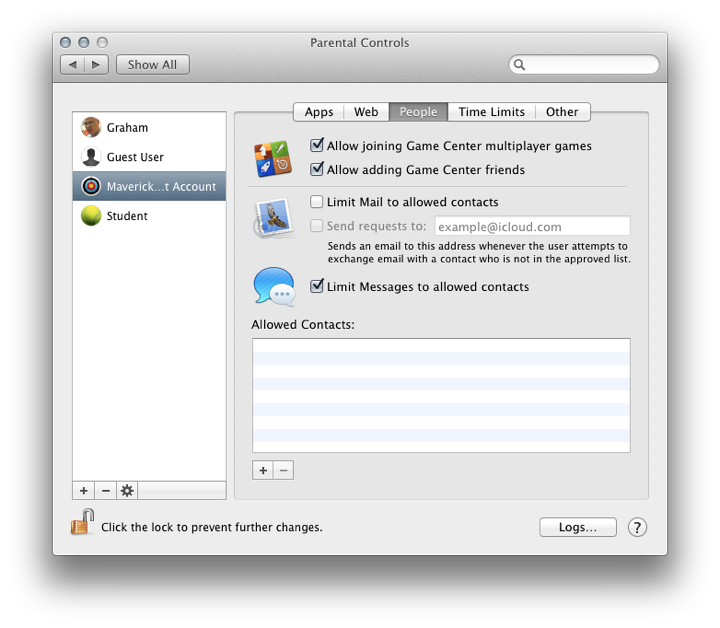
If either of the services is restricted by activating the checkbox, a panel is available into which allowed contacts may be added. When adding such information, a panel appears that requires first name, last name and account details including account name and type of service (email or AIM). A triangle beside the last name opens a contacts panel, allowing one-click adding.
Time LimitsThere are three sections to the Time Limits panel as before: Weekday and Weekend limits, and Bedtime.
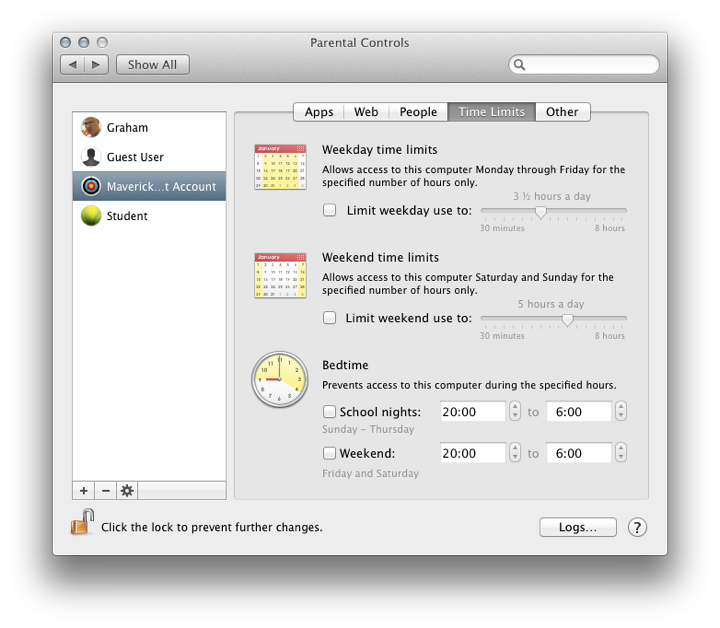
OtherThe final pane in Parental Controls now has 6 checkboxes with the addition of a checkbox to limit control of the built-in camera. Each of the items controls access to a specific feature or function. Changing the password and Limit disk burning have swapped places to reflect the lack of such drives on new Macs.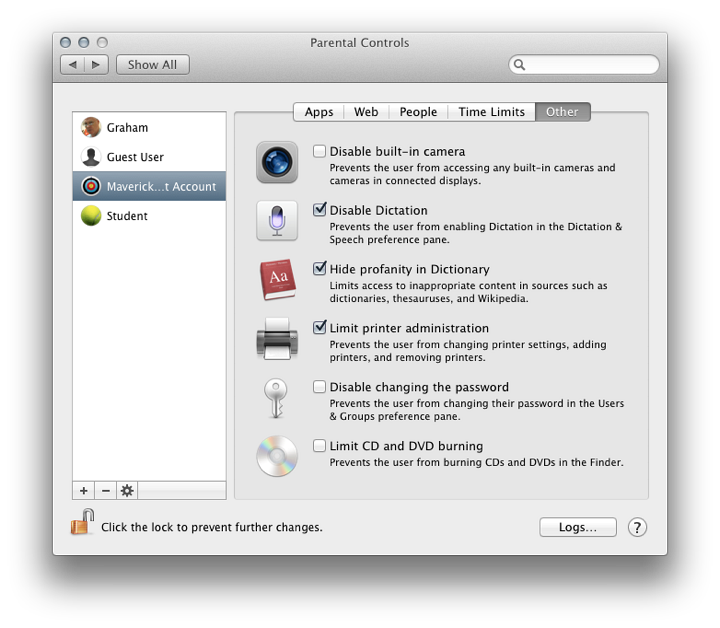
LogsA logs button is available at bottom right of all panels now. Pressing the button reveals a panel which is grouped in four ways: Websites Visited; Websites Blocked; Applications; and Messages.Any data recorded here will provide a detailed report of activity in the account. A button at the top of the panel allows the administrator to select a time limit for retention of any logs: Today, One week (default), One month, Three months, Six months, One year, and All. A second button allows activity to be grouped by Website or by Date. An entry in the list may be viewed or blocked using buttons at the bottom of tis panels
We are reminded of the Peter Steiner cartoon from New Yorker, "On the Internet nobody knows you're a dog." There have been other, more recent reminders (such as the movie, Trust) of how at risk young people can be, as well as many real-life reports. While parents should work with the very young in their online discoveries, those who are a little older value their independence and privacy. They can feel inhibited and resentful if they sense that they are under observation. Parents have to perform a balancing act between that freedom and the protection of their sons and daughters from the malign influences that exist online. The big bad wolf is real.
See Also:
Graham K. Rogers teaches at the Faculty of Engineering, Mahidol University in Thailand where he is also Assistant Dean. He wrote in the Bangkok Post, Database supplement on IT subjects. For the last seven years of Database he wrote a column on Apple and Macs. |
|

For further information, e-mail to

|